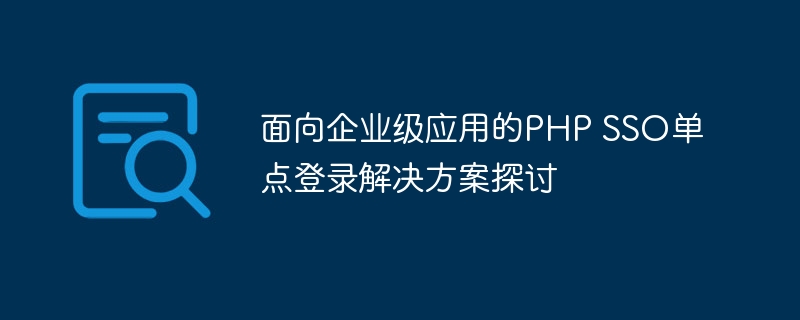

Discussion on PHP SSO single sign-on solution for enterprise-level applications
With the increasing number of enterprise-level applications, users are no longer satisfied with using a single application for work. and life. Instead, they want to be able to integrate multiple apps and log in once to access all associated apps. In this case, single sign-on (SSO) becomes a very important solution, which can provide a seamless method of user authentication and access control.
In the field of PHP development, there are many feasible SSO implementation solutions. This article will discuss a PHP SSO single sign-on solution for enterprise-level applications and provide specific code examples.
First of all, we need to clarify the basic principles of SSO. SSO implements single sign-on by using a central authentication mechanism. In this mechanism, the user only needs to log in once, and during subsequent visits, all related applications will share the user's login status. After the user is authenticated, an encrypted Token will be generated on the server and then passed to other associated applications through cookies, URL parameters, etc.
In our PHP SSO solution, we will use Token-based authentication. The following are the basic steps of the solution:
The following is a simple PHP code example that demonstrates how to pass Token between the certification authority and the associated application.
Auth Center application code example:
<?php
// 在该应用中处理用户的登录请求并生成Token
// 检查用户的用户名和密码
function checkUserCredentials($username, $password) {
// 假设这里进行了一些身份验证逻辑
// 如果验证通过,返回用户ID,否则返回false
}
// 生成Token
function generateToken($userId) {
// 使用用户ID和当前时间戳生成Token
// 这里可以使用加密算法对Token进行签名
return $token;
}
// 处理登录请求
if ($_SERVER['REQUEST_METHOD'] === 'POST') {
$username = $_POST['username'];
$password = $_POST['password'];
$userId = checkUserCredentials($username, $password);
if ($userId) {
$token = generateToken($userId);
// 将Token存储在服务器中,以便其他应用验证
// 并将Token发送给关联应用
} else {
// 登录失败
}
}
?>Associated application (Sub App) code example:
<?php
// 检查用户的登录状态,如果不存在有效的Token,则将用户重定向到认证中心
// 检查Token是否有效
function checkToken($token) {
// 这里可以对Token进行解密和验证
// 如果Token有效,返回用户ID,否则返回false
}
// 获取Token
function getToken() {
// 从Cookie、URL参数等方式中获取Token
}
// 获取关联应用的URL
function getAppUrl() {
// 返回认证中心的URL
}
// 检查用户的登录状态
function checkLoginStatus() {
$token = getToken();
if ($token) {
$userId = checkToken($token);
if ($userId) {
// 用户已登录,继续访问
} else {
// Token无效,重定向到认证中心
header('Location: ' . getAppUrl());
exit();
}
} else {
// Token不存在,重定向到认证中心
header('Location: ' . getAppUrl());
exit();
}
}
// 在关联应用的入口处调用checkLoginStatus()函数
?>The above code example is just a simple demonstration, actual application More complex logic and security measures may be required. In addition, other technologies and tools can be used to enhance the functions and performance of SSO, such as using encryption algorithms to protect tokens and using single sign-out to implement the logout function.
In short, the PHP SSO single sign-on solution for enterprise-level applications can greatly improve user experience and work efficiency. By using a certificate authority, users only need to log in once to access all associated applications. The code example provided in this article serves as a basic implementation method and can be expanded and optimized according to specific needs. I hope this article can help readers understand the basic principles of SSO and provide a feasible solution for the development and architecture of enterprise-level applications.
The above is the detailed content of Discussion on PHP SSO single sign-on solution for enterprise-level applications. For more information, please follow other related articles on the PHP Chinese website!




